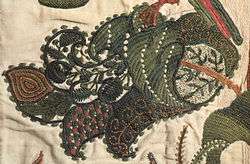Crewel embroidery

Crewel embroidery, or crewelwork, is a type of surface embroidery using wool. A wide variety of different embroidery stitches are used to follow a design outline applied to the fabric. The technique is at least a thousand years old.
The origin of the word crewel is unknown but is thought to come from an ancient word describing the curl in the staple, the single hair of the wool. Crewel wool has a long staple; it is fine and can be strongly twisted. Modern crewel wool is a fine, 2-ply or 1-ply yarn available in many different colours.
Description of the technique
The crewel technique is not a counted-thread embroidery (like canvas work), but a style of free embroidery. Crewelwork had its heyday in Britain in the 17th century, but has come in and out of fashion several times since then. Traditionally, crewel embroidery is done on tightly woven linen twill, though more recently, other fabrics like Matka silk, cotton velvet, rayon velvet, silk organza, net fabric and also jute have been used. A firm fabric is required to support the weight of the stitching. It is best to use a crewel needle to execute the stitches as a needle with a wide body, large eye and a sharp point is required.
The outlines of the design to be worked are often screen printed onto the fabric or can be transferred to plain fabric using modern transfer pens, containing water-soluble ink or air-soluble ink, using a lightbox and a permanent pen, or iron-on designs applied using transfer sheets. The old-fashioned "pinprick and chalk" or "prick and pounce" methods also work well. The prick and pounce method involves transferring the design outlines - printed on paper - by pricking the outline with a needle to produce perforations along the lines. Powdered chalk or pounce material is then forced through the holes onto the fabric using a felt pad or stipple brush in order to replicate the design on the material.
Designs range from the traditional to more contemporary patterns. Traditional design styles are often referred to as Jacobean embroidery featuring highly stylized floral and animal designs with flowing vines and leaves.
Many different embroidery stitches are used in crewelwork to create a textured and colourful effect. Unlike silk or cotton embroidery threads, crewel wool is thicker and creates a raised, dimensional feel to the work. Some of the techniques and stitches include:
- Outlining stitches such as stem stitch, chain stitch and split stitch
- Satin stitches to create flat, filled areas within a design
- Couched stitches, where one thread is laid on the surface of the fabric and another thread is used to tie it down. Couching is often used to create a trellis effect within an area of the design.
- Seed stitches, applied randomly in an area to give a lightly shaded effect
- French knots are commonly used in floral and fruit motifs for additional texture
- Laid and Couched Work
- Long and Short "soft shading"
Crewel embroidery was, in the past, embroidered to create elaborate and expensive bed hangings and curtains. Now it is most often used to decorate cushions, curtains, clothing and wall hangings. Recently several other items such as lamp shades and handbags have been added.
Unlike canvas work, crewel embroidery requires the use of an embroidery hoop or frame on which the material is stretched taut and secured prior to stitching. This ensures an even amount of tension in the stitches, so that designs do not become distorted. Depending on the size of the finished piece, crewelwork is generally executed with a small portable hoop up to large free standing frames (also known as slates).
See also
External links
- Crewel work in TRC Needles
- How Crewel – Feature about the history and development of crewel work, with photographs


